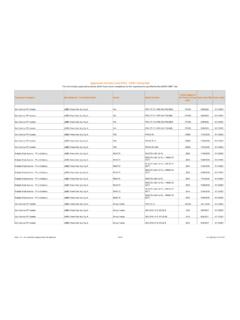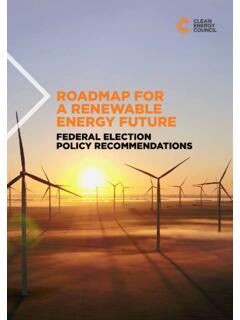Transcription of Wind Best Practice Implementation Guidelines
1 best Practice . Guidelines . For Implementation of wind Energy Projects in Australia June 2018. Acknowledgements Executive summary The Clean Energy Council (CEC) would like to acknowledge This 2013 version of the Clean Energy Council's the support of the Australian Greenhouse Office which best Practice Guidelines for the Australian wind funded the preparation of the original AusWEA best Practice Industry is an update of the original Guidelines , Guidelines 2002 under the Industry Development Component of the Renewable Energy Commercialisation Project. This released in 2006. version of the Guidelines is an update and revision of the The update has modified and edited information to ensure 2006 update of the best Practice Guidelines .
2 Currency and revised the birds and bats appendices from the previous version into one appendix that covers all ecology The CEC wishes to thank Entura for its work on developing considerations. these updated Guidelines , its member companies who provided input into the Guidelines and in particular the best This update has also coincided with the development of Practice Guidelines subcommittee for their efforts on revising Community Engagement Guidelines for the Australian wind Industry. and updating the Guidelines . The Guidelines are intended to be practical and are designed Disclaimer primarily for use by wind farm proponents, owners and operators. The Guidelines are also designed to assist people involved in the planning process, and the general community.
3 The Clean Energy Council, its officers, employees, agents and The Guidelines aim to help the industry and stakeholders advisors: understand the wind farm development process and provide confidence in the level of rigour that can be expected are not liable for the accuracy and reliability of any of proponents when preparing a wind farm proposal for information provided in this publication development approval. make no express or implied representation or warranty that any statement as to future matters contained in this The Guidelines focus on the planning, approval and operational publication will prove correct aspects of onshore wind farms, although sections of the expressly disclaim any and all liability arising from the document may be relevant for offshore wind farms.
4 Inclusion of information contained in this publication guidance specific to offshore wind farms will be considered by the CEC if required in the future. accept no responsibility arising in any way from errors in, or omissions from this publication do not represent that they apply any expertise on behalf of the reader or any other interested party accept no liability for any loss or damage suffered by any person as a result of that person placing any reliance on the contents of this publication. Clean Energy Council | best Practice Guidelines for the Australian wind Industry The Guidelines cover the following stages of wind farm The exact timing of the various activities outlined in these development: Guidelines will vary according to the individual site parameters, jurisdictional requirements and each proponent's internal 1.
5 Identification of stakeholders and approvals pathways systems. As a result, no attempt has been made to provide 2. Site Planning a list of requirements or a schedule that can be universally a. Site selection applied to all developments equally. The proponent will always need to investigate specific timing requirements that may relate b. Project feasibility to a particular site and address these appropriately during the c. Detailed assessment development process. d. Planning and environmental approvals Similarly, the Guidelines do not attempt to comprehensively e. Development application decision identify all approval pathways and/or approval timelines across 2.
6 Site Operations Australia given that these are not only subject to change, but a. Construction can vary immensely based upon the jurisdiction and the nature, b. wind farm operation scale, location and potential impact of the development. c. Decommissioning Information in the main document is supported by appendices The goal of each stage is to identify what is required of a which contain additional information on key areas relevant to best Practice development, while also acknowledging that wind farm development. These are: each wind energy development will be unique and require Appendix 1 - Glossary assessment on its individual merits. The Guidelines are based on what is best Practice for a typical project, acknowledging Appendix 2 - Native title and cultural heritage that projects can range from a single small capacity wind Appendix 3 - Useful websites turbine to a utility scale wind farm with many large capacity Appendix 4 - Aircraft safety wind turbines.
7 The aim of the Guidelines is to describe the Appendix 5 - Landscape assessment environmental, amenity and stakeholder consultation aspects of the planning, approval and operational aspects of wind farms. Appendix 6 - Noise Consideration of technical/commercial and contractual aspects Appendix 7 - Ecological assessment are also included where the issues are of public interest. (Combined Birds and Bats appendices 8 and 9). Appendix 8 - Fire management Guidelines The Guidelines do not replace existing energy or environmental planning legislation, policy or regulations at local, state or Appendix 9 - Electromagnetic interference (EMI). federal levels but can be used to support these assessments.
8 Appendix 10 - wind turbine standards Project proponents must ensure they are developing their Appendix 11 - Environmental Management Framework project according to the current legislation, policy and/or Appendix 12 - wind energy reference publications regulations relevant to the location of their project. The appendices of the Guidelines refer to different legislation, regulations and policy requirements that exist for wind farms throughout Australia, rather than prescribing specific methodologies for assessments or studies. The requirements, or the most appropriate methodologies, often differ depending on the project location and specifications. Such requirements and methodologies would be sourced by proponents from expert consultants and planning authorities.
9 Although the principles behind the Guidelines should remain the same for every development, the work required by a proponent in project design and technical and environmental assessments will vary from project to project. Clean Energy Council | best Practice Guidelines for the Australian wind Industry Commitment to the best Practice Guidelines The Clean Energy Council Attributes of a best Practice wind Farm (CEC) is committed to developing a robust Australian Safe wind community that makes a The wind farm will not negatively affect the health and safety of the significant contribution to safe, community, its employees, contractors and other stakeholders during reliable, economically and its development, construction, operation and decommissioning.
10 Environmentally sustainable energy supply. The CEC represents the Socially sustainable Australian wind community The wind farm proponent will actively seek stakeholder participation and promotes the sensitive and support through well-planned, open, inclusive and responsive and appropriate growth of engagement processes. wind energy in Australia. The proponent will ensure sound and consistent methodologies are applied to assess and identify the most appropriate siting of the wind farm for landscape, amenity and environmental impacts. Economically sustainable The wind farm will make a positive economic contribution to the community in which it is located.





